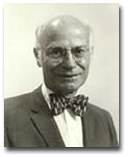 Nathan Wetherell Shock, Ph.D. began his gerontology career in 1941 as the chief of the newly formed Unit on Gerontology of the Division of Physiology of the five-year-old National Institute of Health. He took this two-man aging unit and built it into the internationally respected Gerontology Research Center of the National Institute on Aging, NIH. Dr. Shock was the catalyst for the emergence of aging research in the United States and overseas for nearly half a century.
Nathan Wetherell Shock, Ph.D. began his gerontology career in 1941 as the chief of the newly formed Unit on Gerontology of the Division of Physiology of the five-year-old National Institute of Health. He took this two-man aging unit and built it into the internationally respected Gerontology Research Center of the National Institute on Aging, NIH. Dr. Shock was the catalyst for the emergence of aging research in the United States and overseas for nearly half a century. |
| It was Dr. Shock's insistence on answering what he considered the discipline's two critical questions that made an impact on the field of gerontology: "What are the underlying biological factors that produce what we perceive as aging?" and, "What are the mechanisms that produce impaired performance with age?" For aging, he insisted, was not a disease. |
| Dr. Shock directed NIH intramural aging studies for 35 years until his retirement as first Scientific Director of the National Institute on Aging in 1976. During his leadership he helped plan and implement the construction of the gerontology building (Gerontology Research Center) located on the grounds of what is now the Johns Hopkins Bayview Medical Center in Baltimore, Maryland. In addition, he presided over the recruitment and training of hundreds of scientists and clinicians and the development of five major laboratories covering a wide range of biomedical and psychological research on aging. |
| Dr. Shock was one of the first scientists to foresee the importance of using longitudinal methods to study human aging. In the late fifties, he and his colleagues began the Baltimore Longitudinal Study of Aging that consisted of community-dwelling volunteers that now includes more than 1,400 active subjects. These men and women, aged 20-96 years, visit Baltimore every two years to undergo an extensive series of more than 100 tests to measure age changes over time. |
| Officially retiring in 1977, Dr. Shock continued his work as Scientist Emeritus until his death in 1989. Dr. Shock was the recipient of awards from every major national society on aging, he was a founder (with Kornchevsky) and president of the International Association of Gerontological Societies, and a founding member and president of the Gerontological Society of America. |
|
|
 Nathan Wetherell Shock, Ph.D. began his gerontology career in 1941 as the chief of the newly formed Unit on Gerontology of the Division of Physiology of the five-year-old National Institute of Health. He took this two-man aging unit and built it into the internationally respected Gerontology Research Center of the National Institute on Aging, NIH. Dr. Shock was the catalyst for the emergence of aging research in the United States and overseas for nearly half a century.
Nathan Wetherell Shock, Ph.D. began his gerontology career in 1941 as the chief of the newly formed Unit on Gerontology of the Division of Physiology of the five-year-old National Institute of Health. He took this two-man aging unit and built it into the internationally respected Gerontology Research Center of the National Institute on Aging, NIH. Dr. Shock was the catalyst for the emergence of aging research in the United States and overseas for nearly half a century.

